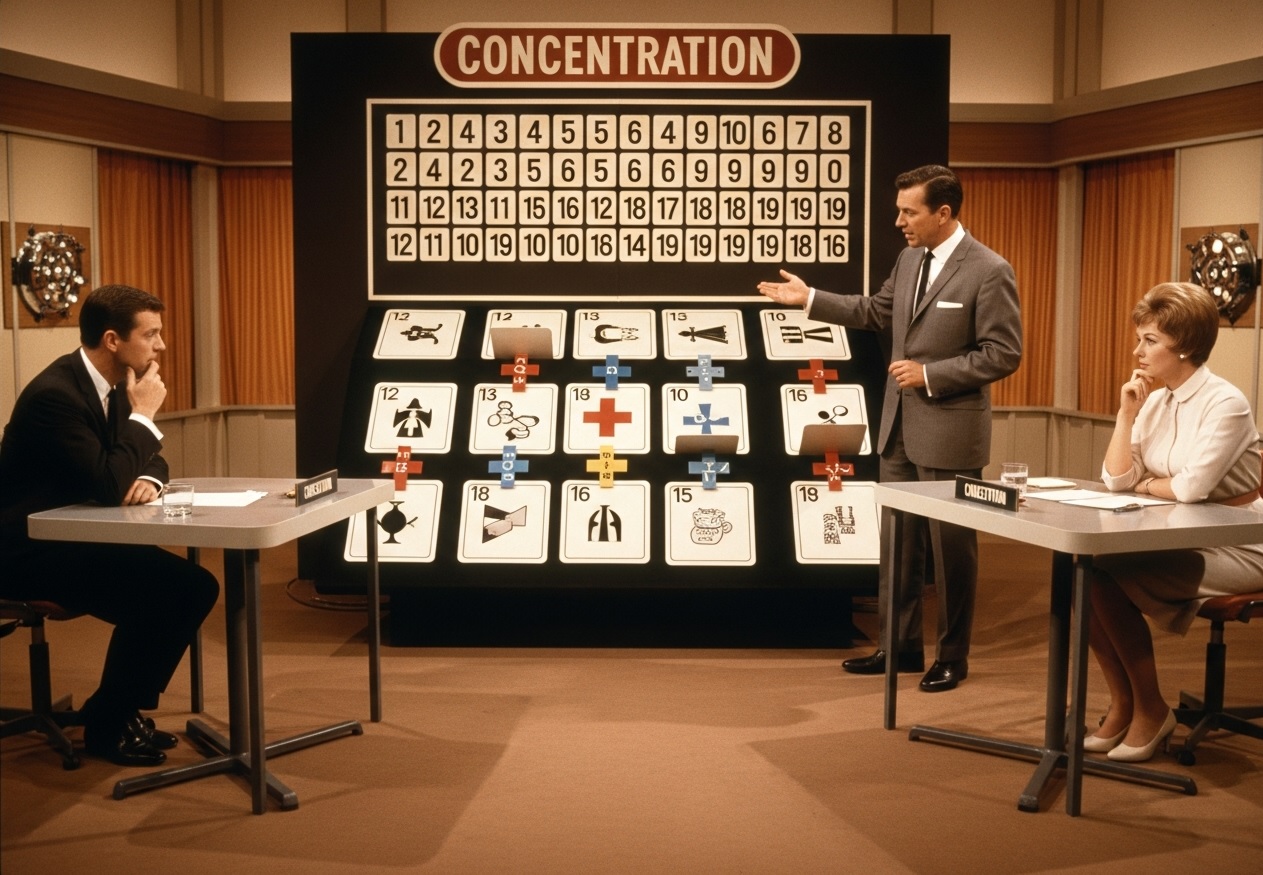Concentration — A Classic Australian Game Show That Tested Memory and Wit

“Concentration” is one of Australia’s most memorable TV game shows, blending memory skills with puzzle solving — a format that held audiences in thrall during its various runs from the late 1950s through to the 1990s. Based on the children’s memory matching game, this show became a staple of Australian television history.
Origins and Broadcast History
The Australian version of Concentration first aired on the Nine Network in **1959**, and ran until 1967. During this black-and-white era, its host was **Philip Brady**, who became closely identified with the format. The show then had a brief revival on the Seven Network in **1970**, hosted by **Lionel Williams**. Finally, after decades off the air, *Concentration* returned for a short-lived revival in **1997**, again on Seven, with **Mike Hammond** as host.
Format: How the Game Worked
At its core, *Concentration* was about matching. Two contestants competed by selecting pairs of “cards” (or tiles) on a board. Each card hid either a prize, a special square, or a piece of a rebus puzzle.
As contestants successfully matched pairs, those cards were removed, gradually uncovering portions of the hidden rebus puzzle underneath. The rebus usually consisted of pictures, symbols or icons that, when fully exposed, formed a phrase or answer.
One of the more interesting twists: certain cards were “Take” cards, meaning a player who matched them could steal a prize from their opponent. There were also wild or special squares in some versions, adding an element of strategy beyond simple memory matching.
The 1997 Revival — What Was New
The 1997 version made several changes to fit a more modern TV format. For instance, the board was reduced in size: contestants faced **25 squares** instead of the original 30.
The bonus round in 1997 offered eight **major prizes**. Behind 15 numbered squares, there were seven matching pairs plus one “decoy” prize, designed to make things trickier. Competitors had a **time limit** — in this revival, new champions started with 40 seconds, with an extra 5 seconds added each time they returned to the bonus round.
If a player managed to match all seven correct pairs before time ran out, they would “retire” from the show with the last prize they uncovered. If they didn’t finish in time, they could continue as a carry-over champion into the next episode.
Hosts Through the Years
Over its lifespan, *Concentration* in Australia was presented by a few notable hosts:
- Philip Brady — the original and most long-running host during the 1959–1967 period.
- Lionel Williams — hosted the 1970 revival.
- Mike Hammond — brought the show back in 1997.
The Cultural Impact of Concentration in Australia
During its first run, *Concentration* was part of the formative years of Australian television, contributing to the early game show landscape. It wasn’t just about memory — the show combined that with the intellectual challenge of solving puzzles, giving it wide appeal across families.
Its legacy is preserved, in part, by the National Film and Sound Archive (NFSA), which holds clips of the show. These archives are important in remembering how Australian TV evolved, especially given that many early broadcasts were not routinely preserved.
Game-show historians often mention *Concentration* among the pioneering formats that helped locally produced Australian quizzes and variety shows gain a foothold, standing alongside other classic formats in the country’s television history.
Why It Worked — The Appeal of the Format
There are a few reasons why *Concentration* resonated so well with audiences:
- Memory + Strategy: The simple act of matching cards was enriched by the strategic “Take” squares and special wild cards.
- Puzzle Solving: The rebus challenge added intellectual engagement — contestants were not just playing for prizes, they were decoding a hidden message.
- Pacing: The pace was well balanced: matching rounds, tension as pieces revealed, and the race against time in the bonus round (in later versions).
- Relatable Format: The game was based on a children’s memory game — something many people would have played, which made the TV version immediately accessible.
Challenges and Decline
Despite its strengths, *Concentration* faced challenges. In the early years, much of television was black and white, and many shows from that era weren’t archived well. This means that full episode preservation is patchy.
The 1997 revival, while nostalgic, did not sustain long-term success. The format may have seemed dated in the face of more modern, flashier game shows that by the late 1990s were evolving rapidly. Furthermore, the tighter time constraints and more aggressive pacing might have changed the feel that originally made the show charming.
Legacy and Influence
*Concentration* is remembered as a trailblazer in Australian game-show history. Even though its television runs have ended, its spirit lives on in several ways:
- It inspired other matching-based shows and memory games in Australia, including a child-friendly version called Match Mates.
- The rebus–plus–memory concept has influenced international revivals; indeed, *Concentration* was adapted into several countries.
- It remains part of Australia’s television heritage — clips still exist in archival institutions, and long-time game-show fans fondly look back on it as a classic.
Conclusion
While *Concentration* may no longer be on air, its impact on Australian television is undeniable. It combined memory, strategy, and puzzle solving into a clean, elegant format that appealed to a wide audience. From Philip Brady’s early hosting era to Mike Hammond’s 1997 revival, the show left a lasting imprint. For anyone interested in classic TV or the history of game shows in Australia, *Concentration* stands out as a beloved and intellectually engaging piece of the medium’s evolution.